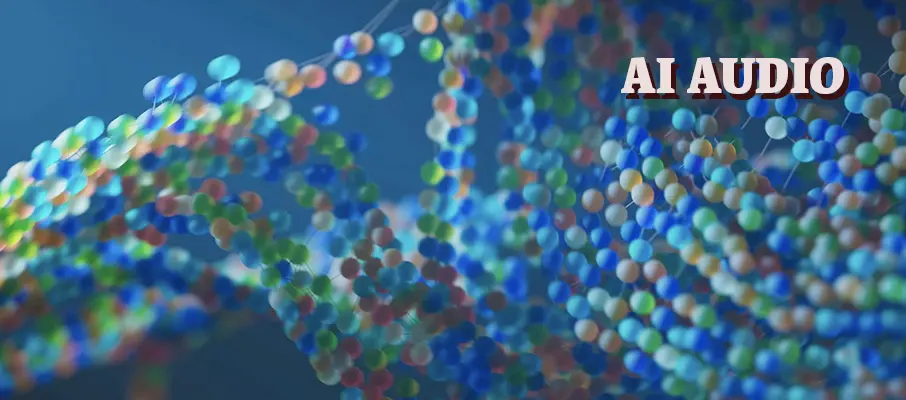
Introduction
Artificial intelligence is no longer just writing emails and generating images—it is composing music, creating synthetic voices, and producing entire videos. In just minutes, AI can generate a song with lyrics, instrumentation, and vocals that sound convincingly human. Platforms like Suno, Udio, and ElevenLabs are putting professional-grade audio tools into the hands of anyone with a laptop, transforming the way music, podcasts, training materials, and even advertisements are produced.
Recent case studies like CBS’s Sadie Winters series illustrate how AI-generated music can evolve from a demo to a viral hit, complete with fan videos and streaming traction. This rapid evolution underscores how AI is democratizing creativity while raising serious questions about authenticity, copyright, and the role of human artistry in an increasingly automated world.
What AI Audio Means for SMB Executives
For business leaders, AI audio is more than a novelty—it’s a strategic opportunity and a potential disruption.
- Efficiency & Cost Savings: AI tools can cut production cycles from weeks to hours, enabling faster campaigns and lower costs for ads, podcasts, and training.
- Creative Expansion: Businesses can experiment with custom soundtracks, branded voices, and synthetic narrators without hiring full creative teams.
- Legal & Ethical Risks: Copyright and ownership of AI-generated works remain unsettled, creating exposure for companies that rely on AI music or voiceovers.
- Brand Authenticity: Consumers are split—some embrace AI-generated media, while others value human connection and transparency. SMBs need to decide whether to lean into synthetic branding or emphasize human creativity as a differentiator.
Audio LLMs and Tools
🌐 Try-It AI Audio Links
AI Audio Tools
AI audio is evolving at lightning speed, with new tools allowing anyone to generate music, clone voices, or clean recordings with just a few clicks. From playful creativity to professional production, audio AI is rapidly becoming part of everyday business and entertainment.
This section showcases the leading AI audio platforms and models — from music generators like Suno and Udio, to expressive voice technologies like Hume and ElevenLabs, to utility tools such as LALAL.AI for stem separation. We’ve also included general LLMs like GPT-5 and Qwen 2.5-Omni, which now feature native speech capabilities, marking the convergence of text and audio.
These cards are designed to help you explore, test, and compare the most impactful AI audio technologies. Whether you’re an SMB executive considering use in marketing, an educator exploring voice synthesis, or a curious creator experimenting with AI music, these “try-it” cards give you a direct way to experience what’s possible.
GPT-5 (Audio)
Conversational voice input & output
OpenAI’s GPT-5 powers the latest ChatGPT apps with native speech input (via Whisper) and naturalistic voice output in multiple styles. Developers can use the Realtime API to build apps with near-instant spoken interaction.
Opens in a new tab. OpenAI/ChatGPT account required.
Meta SeamlessM4T & Voicebox
Multilingual speech translation & generation
Meta’s research companions to LLaMA deliver end-to-end speech translation across 100+ languages and AI voice synthesis. SeamlessM4T focuses on cross-lingual transcription/translation, while Voicebox explores expressive speech generation.
Opens in a new tab. Research preview; not a commercial product.
Suno
Text-to-music song generation
Create full songs from prompts—lyrics, vocals, backing tracks, and styles—directly in the browser. Great for rapid demos, social clips, and exploring genres.
Opens in a new tab. Account may be required.
Udio
AI music generation for creators
Generate catchy tracks in seconds. Strong on pop, EDM, and viral-friendly styles with simple controls and quick iterations.
Opens in a new tab. Account may be required.
ElevenLabs Music
AI-assisted music creation
ElevenLabs’ expansion into music pairs intuitive prompts with quality stems and arrangements—useful for jingles, underscores, and rapid ideation.
Opens in a new tab. ElevenLabs account required.
Hume.ai
Emotion-aware voice generation
Generate expressive voices with control over tone, cadence, and affect. Hume’s empathic voice stack enables more lifelike, conversational audio.
Opens in a new tab. Account required for API access.
ElevenLabs Sound Effects
AI-powered sound design
Instantly create realistic or imaginative sound effects from text prompts. Perfect for podcasts, video production, games, and creative projects.
Opens in a new tab. ElevenLabs account required.
ElevenLabs Voices
High-fidelity TTS & cloning
Industry-leading TTS with natural prosody and robust voice library. Ideal for narration, product videos, and character voices.
Opens in a new tab. ElevenLabs account required.
Play.ht
Scalable TTS for creators & teams
Versatile, developer-friendly TTS with strong API, SSML support, and large voice catalog—great for blogs, apps, and training content.
Opens in a new tab.
LOVO
Expressive TTS & content toolkit
Accessible, emotion-forward voices with tools for ads, e-learning, and social content. Popular for fast production workflows.
Opens in a new tab.
Respeecher
Pro-grade voice cloning
Studio-trusted cloning for film, TV, and games with strong quality controls and licensing workflows.
Opens in a new tab. Approval may be required.
Speechify
Reader-friendly TTS on web & mobile
Mainstream TTS for articles, PDFs, and notes. Good voices, easy apps, and quick exports for content creators.
Opens in a new tab.
Listnr
TTS for blogs & podcasts
Turn articles into audio, embed players, and manage podcast feeds with straightforward controls and monetization-ready outputs.
Opens in a new tab.
LALAL.AI
Stem separation & cleanup
Extract vocals, drums, bass, and more from mixed audio. Handy for remixes, karaoke tracks, and audio post workflows.
Opens in a new tab.
Adobe Podcast Enhance
AI audio cleanup & leveling
Clean noisy recordings, match levels, and improve clarity with a single upload—perfect for quick polish on interviews and VO.
Opens in a new tab. Adobe account may be required.
MAI-Voice-1
Microsoft’s ultra-fast voice model
MAI-Voice-1 can generate one minute of speech in under a second on a single GPU. It powers narration in Copilot Daily and is available for early testing through Copilot Labs.
Opens in a new tab. Microsoft account may be required.
Gemini 2.5 Pro
Google’s multimodal powerhouse
Google’s latest Gemini model handles text, image, audio, video, and code in one interface, with up to 1 million tokens of context. Designed for deep multimodal workflows and enterprise apps.
Opens in a new tab. Google account may be required.
🌐Experience AI Audio with these tools
AI audio is here and growing fast—from generating songs and cloning voices to cleaning and enhancing recordings. This section gives you quick access to the most relevant tools and models, so you can explore how audio AI is transforming creativity, business, and communication.
🔹 Calls to Action (for SMB Executives)
- Experiment responsibly: Test AI audio tools like Suno or Udio for low-cost creative projects, but disclose AI use to maintain audience trust.
- Audit legal exposure: Monitor copyright and licensing rules around AI-generated music, voices, and soundtracks.
- Leverage efficiency: Use AI audio for training, marketing, or podcasts to save production costs and time.
- Differentiate your brand: Decide whether to highlight human artistry as a unique value or embrace AI-driven speed and scale.
- Track cultural shifts: Follow how consumers respond to AI-generated music and voices—public perception may shape adoption.
Leading AI Audio & Music Generation Tools (2025)
Music Creation & Synthetic Artists
- Suno AI — A text-to-music generator capable of producing vocals and instrumentation from user prompts, now at version 4.5+ (released July 2025). It has already moved toward mainstream adoption—one user even secured a recording deal as an AI-based creator (Reddit, Wikipedia).
- Udio — Another text-to-music model that crafts realistic-sounding vocals and rich instrumentation. It offers remix features and prompts-based song extensions. While celebrated for its output quality, copyright concerns have arisen over its training data (Wikipedia).
- Boomy, Beatoven, Mubert, Riffusion, AIVA — Versatile tools for song generation:
- Boomy and Suno AI excel in quick, catchy song creation.
- Beatoven and Mubert focus on background music loops.
- Riffusion uses spectrogram-to-audio creative transformations.
- Soundraw — Known for its intuitive UI and granular control over track elements like melody, rhythm, bass, and mood. Enables royalty-free export with professional polish (Soundraw).
- Humtap — Generates music from user humming or tapping, though its output sometimes lacks high-end polish (One Submit).
Voice & AI Speech Generation
- ElevenLabs — Renowned for natural and expressive speech synthesis. The newly launched Eleven Music now extends capabilities to AI-generated music with genre, structure, and multilingual controls, designed for commercial use (Wikipedia).
- Other popular voice tools: Murf AI, Resemble AI, Speechify, Synthesys, Play HT, LOVO AI, Listnr, Respeecher (Analytics Vidhya).
Music Production & Post-Processing
- LALAL.AI and MOISES.AI — Highly effective for audio separation and stem extraction with high fidelity—essential for remixing and sampling workflows (Tracklib.com).
- Output’s Re-imagine (Co-Producer plugin) — Uses AI to create unique variations of existing music samples to bypass copyright issues. It reworks sample characteristics, offering royalty-free, customizable outputs (MusicRadar).
Platform & Marketplace Tools
- YouTube Music Assistant — Integrated into YouTube Creator Music, this AI tool generates royalty-free instrumental tracks based on prompt inputs (e.g., “uplifting workout music”) (The Verge).
Why This Matters for Business
Each of these tools demonstrates different facets of the AI audio landscape:
- Creative experimentation (Suno, Udio, Boomy, Soundraw).
- Voice synthesis and realtime audio (ElevenLabs, others) — great for demonstrating both narrative and musical use cases.
- Editing, remixing, and IP-friendly workflows (LALAL.AI, Output) — essential for discussing legal and ethical considerations.
- Accessible tools for creators (YouTube Music Assistant) — ties into democratizing content creation for SMBs.
AI Audio Summaries
Introduction: The State of AI-Generated Pop Music
The music industry is already wrestling with copyright, compensation, and cultural impact. AI-generated tracks are being uploaded to Spotify without proper labeling, and deepfake vocals of pop stars like Taylor Swift or Drake are blurring the line between homage, parody, and infringement. For SMB executives, these debates foreshadow the legal and reputational challenges that will soon affect not just entertainment, but any business that integrates AI-generated media into marketing, training, or customer engagement.
Below are current audio articles referencing AI developments.
Update: September 27, 2025
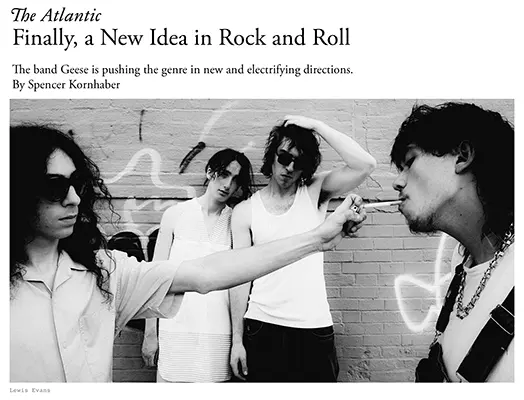
“Finally, a New Idea in Rock and Roll” — The Atlantic (Sept 26, 2025)
The Atlantic highlights how AI-generated music projects are beginning to compete with traditional bands, raising concerns about whether rock has grown stagnant. An AI “synthetic music project” called Velvet Sundown recently amassed over 3 million streams, prompting questions about authenticity and creativity in music.
Against this backdrop, the Brooklyn-based band Geese demonstrates how human originality still pushes genres forward. Their latest album Getting Killed blends influences from punk, jazz, Radiohead, and Frank Zappa, creating a chaotic but compelling sound. The article notes that Geese—growing up with streaming access to nearly all recorded music—shares something with AI: the ability to draw from vast libraries of sound. But unlike algorithms, their creative choices remain deeply human, messy, and surprising.
The piece frames Geese as part of a new wave of bands resisting cultural burnout by producing unpredictable, even disorienting, music that mirrors today’s fragmented information landscape. While AI can replicate past sounds, artists like Geese show that emotional risk-taking and live collaboration still define innovation.
Relevance for Business
For SMB executives and managers, the Geese example illustrates how AI democratizes access to massive knowledge bases, but human creativity remains a differentiator. Just as Geese blends decades of musical styles into fresh work, businesses can combine AI-driven insights with human intuition to build unique products, campaigns, and experiences. The parallel underscores a competitive truth: AI provides the tools, but people provide originality and resonance.
Calls to Action
🔹 Balance AI with Human Creativity — Use AI to analyze trends and streamline processes, but rely on teams to add originality, context, and emotion.
🔹 Leverage AI’s “music library” effect — Apply AI to explore vast datasets, markets, or archives, then task staff with identifying meaningful patterns.
🔹 Anticipate cultural shifts — Monitor how AI is reshaping creative industries (music, film, design) as a lens for how your own sector may evolve.
🔹 Position human work as premium — Highlight originality, authenticity, and risk-taking as brand values in an AI-saturated market.
Summary Created By ReadAboutAI.com
https://www.theatlantic.com/culture/2025/09/geese-getting-killed-album-review/684380/: AI AUDIO https://www.youtube.com/watch?v=fH6j16IwE2Y: AI AUDIO https://www.youtube.com/watch?v=Phh3oVCtzBg: AI AUDIOSadie Winters
CBS’s continuing coverage of Sadie Winters provides a striking lens into the rapid evolution of AI in the music industry. What began as a simple demonstration of AI-generated songwriting has quickly expanded into a viral phenomenon—complete with streaming traction, fan-made videos, and now a full music video produced entirely by a non-musician using off-the-shelf AI tools. Together, these stories show how synthetic artists can capture real-world audiences, spark cultural debate, and raise pressing questions around authenticity, ownership, and the role of human creativity. For businesses, the Sadie Winters case isn’t just about music—it’s a preview of how AI can democratize production, disrupt markets, and reshape consumer expectations across industries.
AI AUDIO Updates: September 3, 2025
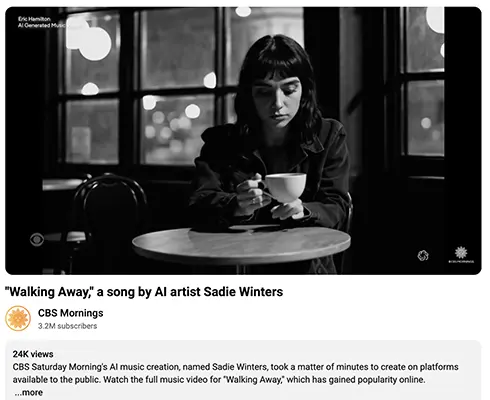
Sadie Winters’ AI “Walking Away” Music Video: Fiction Turns Into Viral Reality
CBS’s second follow-up on Sadie Winters takes the story from a novelty song to a full AI-generated music video. What began as a quick experiment with AI tools has now evolved into a convincing, emotionally charged video created by a non-musician using OpenAI’s text-to-video models. With more than a million followers and viral reach across platforms, Sadie’s rise challenges traditional ideas of artistry—her haunting lyrics and visuals feel authentic, yet she doesn’t exist. Industry veterans are raising concerns about ownership, authenticity, and cultural impact, while audiences continue to embrace the music as if it were human-made.
This development highlights how fast AI is democratizing creativity. Non-musicians can now produce professional-quality music videos in hours, not months, bypassing barriers that once required studios, labels, and budgets. For SMB executives, the Sadie Winters phenomenon is a wake-up call: synthetic content is no longer experimental—it’s market-ready and capable of winning audiences. The unresolved legal and ethical questions only heighten the urgency for businesses to prepare.
Relevance for Business
The Sadie Winters case shows how AI is collapsing production timelines and lowering barriers to entry for creative industries. Businesses that depend on music, video, or cultural branding need to plan for a landscape where synthetic artists compete for attention and potentially disrupt existing models of licensing, fan engagement, and intellectual property.
Calls to Action
- Evaluate brand strategy: Explore whether AI-generated personas or content can complement your marketing or storytelling.
- Prepare for legal flux: Track developments in copyright law regarding AI-generated work—ownership is unsettled.
- Benchmark speed & costs: Compare how AI tools can shorten production cycles versus traditional creative pipelines.
- Engage audiences carefully: Weigh authenticity and transparency—customers may value disclosure about AI-created work.
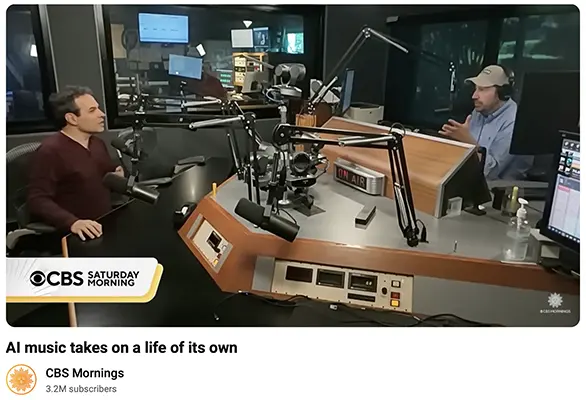
CBS Follow-up to original story on AI audio
Sadie Winters: When AI Music Becomes a Movement
CBS’s follow-up on Sadie Winters—a fully AI-generated singer whose debut song Walking Away was created in under three minutes—highlights how quickly synthetic artists can capture real-world attention. What began as a CBS Saturday Morning experiment is now being broadcast on radio, referenced by Joe Rogan, and even inspiring fan-made videos through AI video models. While critics question whether fans will truly connect with artists who don’t exist, the speed and scale of Sadie’s rise underscore how AI is blurring the line between cultural experiment and commercial opportunity.
At the heart of the discussion are unresolved questions of copyright, ownership, and authenticity. Since works generated entirely by AI are currently not copyrightable, companies and creators face legal ambiguity over who controls music, images, and personas like Sadie Winters. For SMB leaders, this isn’t just a curiosity—it’s a signal of how AI could democratize creative industries while also creating new business, legal, and reputational risks. The debate echoes past disruptions like synthesizers and sampling, but with an exponential twist: AI allows anyone with an idea to become a “musician” overnight.
Relevance for Business
The Sadie Winters case is more than a novelty; it’s a preview of how AI-generated personas can compete with—or complement—human creativity. SMB executives in media, marketing, and entertainment must pay attention: synthetic artists may reshape licensing models, fan engagement strategies, and brand partnerships. Businesses that rely on music, video, or creative content will need to plan ahead for both opportunities and risks.
Calls to Action
- Assess content use: Audit how your business relies on music and creative assets—AI content may lower costs but raise legal exposure.
- Monitor copyright law: Stay updated on rulings about AI-generated work, as ownership questions remain unsettled.
- Explore synthetic branding: Consider if AI personas or voices could enhance marketing campaigns, customer engagement, or internal training.
- Prepare for disruption: Benchmark how AI music and video tools could democratize competition in your industry.
Original CBS Saturday Morning Story on AI Audio
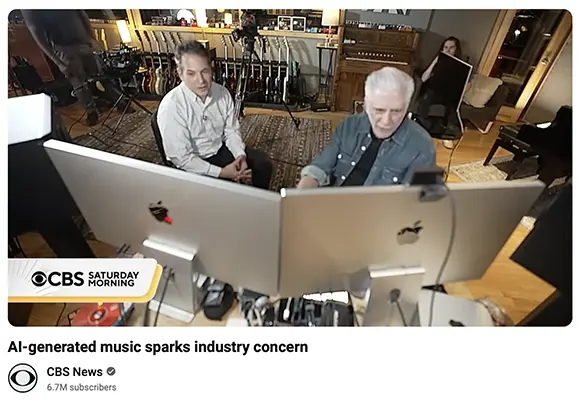
CBS Saturday Morning story on AI-generated music, August 16, 2025
Executive Summary
The CBS Saturday Morning feature highlighted how artificial intelligence is rapidly transforming the music industry by generating fully produced songs—complete with lyrics, artwork, vocals, and production—in just minutes. Using tools like Suno, entirely fictitious artists with realistic voices and songs are gaining traction on streaming platforms, some with millions of followers. While audiences often cannot distinguish AI-generated tracks from human work, musicians and industry professionals expressed ethical concerns, especially regarding authenticity, compensation, and cultural impact. The story underscored how AI blurs the line between creativity and replication, leaving questions about regulation, artist protections, and the role of human connection in art.
Relevance for Business
For SMB executives, this development offers both opportunities and risks:
- Efficiency & Creativity Boost: Just as in music, AI can accelerate creative output across industries—marketing campaigns, content creation, training materials, and customer experiences.
- Brand Authenticity at Stake: The inability of consumers to distinguish between AI- and human-generated work raises ethical questions for businesses that rely on trust, originality, or storytelling.
- Regulatory Uncertainty: Similar to music copyright battles, SMBs using AI may face shifting legal landscapes around intellectual property and transparency.
- Consumer Perception Divide: While some audiences embrace AI-generated products, others view them as inauthentic, creating reputational risks for companies seen as replacing human creativity.
Calls to Action for Executives & Managers
- Audit Creative AI Use: Review where your business may be using AI to generate creative assets (ads, blogs, visuals, training content). Ensure transparency and disclosure.
- Evaluate Brand Positioning: Decide whether to highlight human creativity as a differentiator or to embrace AI speed as a competitive edge.
- Track Regulation: Stay updated on copyright, AI transparency, and disclosure laws—especially if your business relies on creative or intellectual property.
- Protect Human Talent: Consider hybrid strategies—AI for ideation and speed, humans for authenticity and emotional connection.
- Scenario Plan: Prepare for potential consumer backlash or ethical scrutiny if AI-generated work is mistaken for human-created content.
The Promise and The Challenge
AI audio represents both the promise of limitless creative potential and the challenge of navigating authenticity and ownership. For SMB executives, the key is not whether AI audio will matter—it already does—but how quickly and strategically they choose to engage with it.
AI Audio—Advances & Criticisms
- The success of AI music creators sparks debate on future of music industry – Associated Press explores how AI tools like Suno and Udio are enabling non-musicians to break into the music scene, the rise of “AI slop,” and legal battles with big labels over copyright and compensation. (AP News)
- CEO Keynote: AI in the Music Industry – Should You Fight It … – Sonarworks CEO dissects whether AI is hype or here to stay, noting that listeners may not detect AI-generated songs anymore—even sometimes preferring them—while outlining risks and strategic implications for producers, labels, and live venues. (Sonarworks)
- When the bubble bursts… AI in music production – where should we draw the line? – MusicRadar offers a critical tempering of AI excitement by calling for transparency—especially regarding AI-generated acts like Velvet Sundown—and urges ethical boundaries, pointing out AI still lacks genuine reasoning or artistic understanding. (MusicRadar)
- AI’s Impact On Music In 2025: Licensing, Creativity And … – Forbes (Dec 2024) outlines concerns that as AI saturates the creative landscape, independent artists may be priced out and unable to compete in a crowded market. (Forbes)
- The Impact of Artificial Intelligence on Music Production – A scholarly 2025 analysis via NHSJS highlighting how tools like OpenAI’s MuseNet, Google’s Magenta, and Amper Music are reshaping creative processes, with implications for ethics, authorial rights, and economic shifts. (NHSJS)
- AI-Generated Music Detection and its Challenges – A research paper demonstrating that AI-generated music can be detected with near-perfect accuracy—and the broader challenges of deploying such detection systems. (arXiv)
Velvet Sundown—The AI-Band Phenomenon
- The Velvet Sundown: The AI Band Controversy Explained – From Berklee Now, this piece lays out the backstory of the AI‑generated band: its rapid rise, admissions of synthetic creation, and its role as an artistic provocation on identity in music. (Berklee)
- An AI-generated band got 1 m plays on Spotify. Now music insiders say listeners should be warned – The Guardian covers how the Velvet Sundown reached massive listenership despite no human members—and outlines industry concerns over lack of AI labeling on streaming platforms. (The Guardian)
- The Velvet Sundown’s AI saga is 2025’s weirdest music story – The Fader breaks down the band’s rapid rise, fake images, the hoax spokesperson, and reveals how the story unraveled into a bizarre commentary on authenticity and trolling. (The FADER)
- Is Velvet Sundown 2025’s Band of the Summer? – Jefferson Public Radio (via NPR) examines the viral popularity of Velvet Sundown, the question of AI in playlists, and consumer fascination. (IJPR)
- A ’60s‑flavored band blew up on Spotify. They’re AI. – The Washington Post reports on the Velvet Sundown’s folk-rock aesthetic, viral streaming numbers, and the ethical conversations about AI displacing traditional musicians. (The Washington Post)
- Burgarbilden avslöjade populära bandet: Finns inte på riktigt – Omni (Swedish tech media) details how a bizarre image featuring thumb-less band avatars triggered the revelation that Velvet Sundown were entirely AI-created—and Spotify’s muted response. (Omni)
Here are two notable Rolling Stone Culture Council posts that explore AI-generated music—one reflecting on its cultural implications and another on its broader transformations in creation and consumption:
“AI-Generated Music: A Creative Revolution or a Cultural Crisis?”
Published ~10 months ago, this article dissects the viral “Heart on My Sleeve” deepfake featuring Drake and The Weeknd. It probes whether AI music is an innovation unlocking new creative horizons—or a cultural threat to authenticity, emotion, and human artistry. It raises ethical and ownership dilemmas, spotlighting artists like Grimes who are embracing AI as a collaborative partner. (Rolling Stone Culture Council)
“The Future of Music: How AI Is Changing the Way We Create & Consume”
Published ~9 months ago, this post envisions AI not just as a tool, but as a creative partner. It highlights how anyone can generate an entire song from a prompt, explores AI‑driven playlist personalization, and frames AI as the driving force in a democratized music evolution. (Rolling Stone Culture Council)
Here’s a list of the top influential music print publications.
United States
Billboard – Industry-focused, known for its charts, business reporting, and deep dives into the economics of music.
Spin – Alternative rock and pop culture publication, strong in commentary and artist features.
Pitchfork (Conde Nast) – Though primarily digital, it retains authority as a music tastemaker, particularly for indie and experimental genres.
DownBeat – Historic U.S. magazine (since 1934) focused on jazz, blues, and roots music.
United Kingdom
- NME (New Musical Express) – Once weekly, now primarily digital, but still highly influential in rock, pop, and UK indie coverage.
- Mojo – Monthly UK magazine with long-form features, historical retrospectives, and deep artist profiles.
- Uncut – Focuses on classic rock, Americana, and in-depth artist interviews; also includes film and culture.
- Q Magazine (ceased print in 2020, but archives still influential) – Notable for accessible mainstream coverage, still referenced in UK media.
- The Wire – British avant-garde and experimental music magazine, known for niche but highly respected coverage.
- Uncut – Focuses on classic rock, Americana, and in-depth artist interviews; also includes film and culture.
⚡ Additional notable mentions:
Clash (UK) – Covers fashion, pop, and forward-looking music scenes.
Kerrang! (UK) – Essential for rock, punk, and metal coverage.
JazzTimes (US) – Strong niche in jazz criticism and reporting.
How These Publications Are Covering AI Audio
| Rolling Stone | (thewire.co.uk, Pitchfork, Pitchfork, Mojo, Rolling Stone Culture Council) – The Future of Music: How AI Is Changing the Way We Create & Consume (Rolling Stone Culture Council) |
| Spin | (No results found in this search) |
| Pitchfork | – How AI Tools Are Turning Words Into Music (Google MusicLM) (Pitchfork) – How AI Wreaked Havoc on the Lo‑Fi Beat Scene (Pitchfork) – The Battle to Save the Soul of City Pop From AI (Pitchfork) |
| NME | – AI-generated songs added to deceased musicians’ Spotify pages without permission (NME) – Mac DeMarco criticizes AI‑generated music: “We’re in a weird place” (NME) |
| Mojo | – Steve Marriott AI Row: “It’s totally wrong!” (Mojo) |
| Uncut | – Jerry Garcia’s voice recreated by AI for listening experiences (Uncut) |
| The Wire | – Engineered Phantoms: AI tools & DIY sounds (thewire.co.uk) – 13 Ways of Looking At AI, Art & Music(Jennifer Walshe) (thewire.co.uk) |
| DownBeat | (No relevant results found) |
Conclusion: AI Audio Developments
Artificial Intelligence is not just reshaping offices and factories—it is now composing songs, generating voices, and even producing entire music videos. In a matter of minutes, AI tools can create convincing tracks with lyrics, instrumentation, and vocals that sound like they came from a professional studio. This is no longer a futuristic experiment; it’s happening today with viral cases like Sadie Winters and Velvet Sundown, AI-generated “artists” who gained real-world audiences across streaming platforms and social media.
What makes AI audio unique isits accessibility. With platforms like Suno, Udio, and ElevenLabs, non-musicians can instantly create polished audio, while businesses can produce voiceovers, jingles, or podcasts without expensive recording sessions. This democratization lowers barriers, accelerates creative timelines, and introduces fresh opportunities for companies of every size. At the same time, it raises questions: What does “authenticity” mean when a song or voice doesn’t come from a human?
The music industry is already wrestling with copyright, compensation, and cultural impact. AI-generated tracks are being uploaded to Spotify without proper labeling, and deepfake vocals of pop stars like Taylor Swift or Drake are blurring the line between homage, parody, and infringement. For SMB executives, these debates foreshadow the legal and reputational challenges that will soon affect not just entertainment, but any business that integrates AI-generated media into marketing, training, or customer engagement.
For ReadAboutAI.com, AI audio represents an exciting frontier. This page brings together the latest tools, case studies, and controversies, offering executives a clear view of where AI-driven sound is heading. Whether you’re curious about experimenting with AI-generated music for your brand or simply want to understand the risks and opportunities, this section provides both context and actionable insights into one of the most fascinating—and disruptive—areas of AI today.
↑ Back to Top
